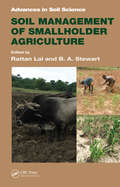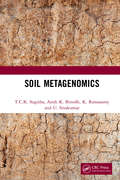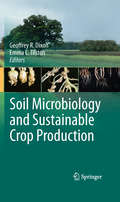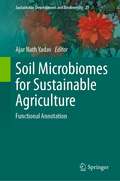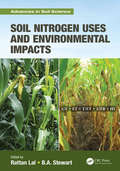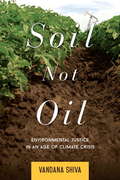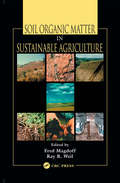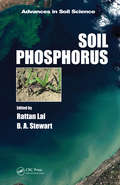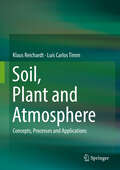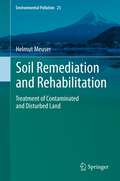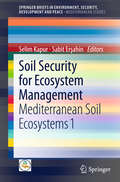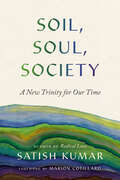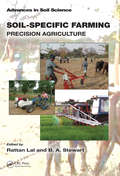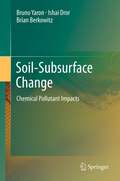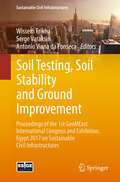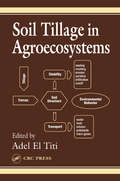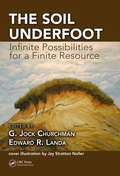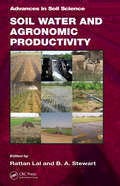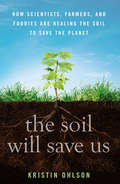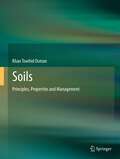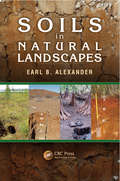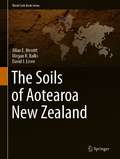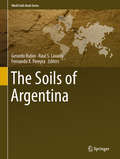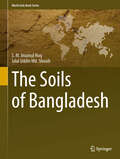- Table View
- List View
Soil Management of Smallholder Agriculture (Advances in Soil Science)
by Rattan Lal B. A. StewartNearly two billion people depend on hundreds of millions of smallholder farmers for food security. Yet, these farmers' lives also hang in the balance due to their extreme vulnerability to the risks of soil degradation and depletion, soil exhaustion, climate change, and numerous biotic and abiotic stresses. Soil Management of Smallholder Agriculture
Soil Metagenomics
by T.C.K. Sugitha Asish K. Binodh K. Ramasamy U. SivakumarThis book focuses on the recent advents and technological breakthroughs in metagenomic approaches coupled with their applications in agriculture. The intended audience include soil and environmental microbiologists, molecular biologists and policy makers. The book expertly describes the latest fourth generation metagenomic technologies from sample collection to data analysis, metatranscriptomic, metaproteomic and metabolomics studies Note: T& F does not sell or distribute the Hardback in India, Pakistan, Nepal, Bhutan, Bangladesh and Sri Lanka.
Soil Microbiology and Sustainable Crop Production
by Geoffrey R. Dixon Emma L. TilstonSoils into which crop plants root and from which they obtain essential minerals and water contain huge arrays of microbes. Many have highly beneficial effects on crop growth and productivity, others are pathogens causing diseases and losses to yield and quality, a few microbes offer protection from these pathogenic forms and others have little or no effect. These intimate and often complex inter-relationships are being explored with increasing success providing exciting opportunities for increasing crop yields and quality in sustainable harmony with the populations of beneficial soil microbes and to the detriment of pathogens. This book explores current knowledge for each of these aspects of soil microbiology and indicates where future progress is most likely to aid in increasing crop productivity by means which are environmentally benign and beneficial.
Soil Microbiomes for Sustainable Agriculture: Functional Annotation (Sustainable Development and Biodiversity #27)
by Ajar Nath YadavThis book encompasses current knowledge of soil microbiomes and their potential biotechnological application for plant growth, crop yield, and soil health under the natural as well as harsh environmental conditions for sustainable agriculture. The microbes are ubiquitous in nature. The soil is a natural hotspot of the soil microbiome. The soil microbiome plays a critical role in the maintenance of global nutrient balance and ecosystem functioning. The soil microbiomes are associated with plant ecosystems through the intense network of plant–microbe interactions. The microbes present in bulk soil move toward the rhizospheric region due to the release of different nutrients by plant systems. The rhizospheric microbes may survive or proliferate in rhizospheric zone depending on the extent of influences of the chemicals secreted into the soil by roots. The root exudates contain the principal nutrients factors (amino acids, glucose, fructose, and sucrose). The microbes present in rhizospheric region have capabilities to fix atmospheric nitrogen, produce different phytohormones, and solubilize phosphorus, potassium, and zinc. The plant systems take these nutrients for their growth and developments. These soil and plant associated microbes also play an important role in protection of plants from different plant pathogenic organisms by producing different secondary metabolites such as ammonia, hydrogen cyanide, siderophores, and hydrolytic enzymes. The soil microbiomes with plant growth-promoting (PGP) attributes have emerged as an important and promising tool for sustainable agriculture. The soil microbiomes promote the plant growth and enhance the crop yield and soil fertility via directly or indirectly different plant growth-promoting mechanism. The soil microbes help the plant for adaptation in extreme habitats by mitigating the abiotic stress of high/low temperatures, hypersalinity, drought, and acidic/alkaline soil. These PGP microbes are used as biofertilizers/bioinoculants to replace the harmful chemical fertilizers for sustainable agriculture and environments.The aim of the book “Soil Microbiomes for Sustainable Agriculture” is to provide the recent advances in mechanisms of plant growth promotion and applications of soil microbiomes for mitigation of different abiotic stresses in plants. The book is useful to scientists, researchers, and students related to microbiology, biotechnology, agriculture, molecular biology, environmental biology, and related subjects.
Soil Nitrogen Uses and Environmental Impacts (Advances in Soil Science)
by Rattan Lal B. A. StewartNitrogen (N) is potentially one of the most complex elements on the Earth. It is necessary for all biological activity, but creates negative impacts on water and air quality. There is a balancing act between deficiency and surplus and the forms of N available further complicate our understanding of the dynamics. Biological fixation provides some plants with N supply while others are totally dependent upon N being available in the soil profile for the roots to extract. Nevertheless, the demand for N will increase because the human population with its increasing growth requires more protein and thus more N. Understanding the global N cycle is imperative to meeting current and future nitrogen demands while decreasing environmental impacts. This book discusses availability, production, and recycling of N in air, water, plants, and soils. It features information on N impacts to soil and water quality, management of N in agroecosystems, and techniques to maximize the use efficiency while minimizing the risks of leakage of reactive N into the environment. This volume in the Advances in Soil Science series is specifically devoted to availability, production, and recycling of N with impact on climate change and water quality, and management of N in agroecosystems in the context of maximizing the use efficiency and minimizing the risks of leakage of reactive N (NO-3, N¬2O) into the environment.
Soil Not Oil
by Vandana ShivaIn Soil Not Oil, Vandana Shiva explains that a world beyond dependence on fossil fuels and globalization is both possible and necessary. Condemning industrial agriculture as a recipe for ecological and economic disaster, Shiva champions the small, independent farm: their greater productivity, their greater potential for social justice as they put more resources into the hands of the poor, and the biodiversity that is inherent to the traditional farming practiced in small-scale agriculture. What we need most in a time of changing climates and millions who are hungry, she argues, is sustainable, biologically diverse farms that are more resistant to disease, drought, and flood. "The solution to climate change," she observes, "and the solution to poverty are the same." Soil Not Oil proposes a solution based on self-organization, sustainability, and community rather than corporate power and profits.
Soil Organic Matter in Sustainable Agriculture (Advances In Agroecology Ser.)
by Fred Magdoff Ray R. WeilRecognition of the importance of soil organic matter (SOM) in soil health and quality is a major part of fostering a holistic, preventive approach to agricultural management. Students in agronomy, horticulture, and soil science need a textbook that emphasizes strategies for using SOM management in the prevention of chemical, biological, and physic
Soil Phosphorus (Advances in Soil Science)
by Rattan Lal B. A. StewartPhosphorus is an essential plant nutrient, but global population growth has dramatically reduced the availability of phosphorus fertilizer resources. Despite this scarcity, there remain numerous problems associated with the excessive and inappropriate use of phosphorus leading to non-point source pollution and eutrophication of natural waters. Identifying appropriate systems for managing soil phosphorus and reducing the risks of eutrophication are needed to minimize the environmental risks. This book focuses on the availability and recycling of phosphorus; regulatory and policy issues of sustainable phosphorus use; and water quality management in agroecosystems pertaining to phosphorus. Sections are dedicated to global phosphorus reserves; cycling and pathways of phosphorus; phosphorus in agriculture; human dimensions and policy intervention; and research and development priorities. Phosphorus is a finite but crucial resource and is an essential element to all life. Sub-optimal availability and nutrient imbalance in the root zone can adversely impact plant growth, and the quality of food and feed grown on these soils. However, the proven reserves of phosphorus can hardly be adequate for a few centuries only. Yet, its misuse and mismanagement has caused severe problems of eutrophication of water and pollution of the environment. Thus, judicious management of soil phosphorus is essential. This volume is specifically devoted to availability and recycling of phosphorus, regulatory/policy issues of sustainable use of phosphorus, and management in agroecosystems in the context of maximizing the use efficiency and minimizing the environmental risks of water quality.
Soil, Plant and Atmosphere: Concepts, Processes and Applications
by Klaus Reichardt Luís Carlos TimmThis textbook presents the concepts and processes involved in the soil-plant-atmosphere system as well as its applications in the water cycle in agriculture. Although reaching the frontier of our knowledge in several subjects, each chapter starts at the graduation level and proceeds to the post-doctoral level. Its more complicated subjects, as math and physics, are well explained, even to readers not well acquainted with these tools. Therefore, it helps students read, understand, and developing their thoughts on these subjects. Instructors also find it an easy book with the needed depth to be adopted in courses related to Soil Physics, Agricultural Management, Environmental Protection, Irrigation and Agrometeorology. It serves also as “lexicon” to engineers and lawyers involved in agricultural, environmental cases.
Soil Remediation and Rehabilitation
by Helmut MeuserThis book provides a comprehensive overview of remediation and rehabilitation techniques and strategies for contaminated and anthropogenically disturbed land. Rehabilitation approaches in the urban environment, such as brownfield redevelopment and urban mining, are discussed. In relation to contaminated land, techniques for soil containment and decontamination of soil, soil vapour and groundwater are comprehensively and systematically presented. Complicated treatment techniques are schematically depicted and can be readily understood. Agricultural, silvicultural and environmentally sustainable rehabilitation strategies for reclaiming disturbed land/terrain in former mining or natural-resource extraction areas, such as open-cast mines, quarries, harvested peatlands, and subsided mining terrain (sinkholes), are introduced. This book will be a useful tool for students, researchers, private consultants and public authorities engaged in the treatment of contaminated or disturbed land.
Soil (Rocks and Minerals)
by Melissa StewartHave you ever wondered how soil is different from dirt, or where soil comes from? Do you know the different animals and organisms that live in soil? What are the many ways that we use soil? Read Soil to find the answers to these questions and many more. You'll also find a hands-on activity to try at home or at school, as well as a glossary of unfamiliar words, resources to help you locate additional information, and a useful index.
Soil Security for Ecosystem Management: Mediterranean Soil Ecosystems 1
by Sabit Erşahin Selim KapurThe term "Soil Security" is used in the context of maintaining the quality and quantity of soil needed in order to ensure continuous supplies of food and fresh water for our society. Topics in this unique book on the management of soil sustainability in the Mediterranean region include: soil information, land degradation, land desertification, pedoenvironments, and the carbon cycle and sequestration. One main focus of the book is the description of new approaches that have been adapted with regards to interdisciplinary soil ecosystem management to combat and mitigate desertification. The contributing authors are renowned experts in their fields which cover the subjects on traditional as well as innovative land use and management.
Soil, Soul, Society: A New Trinity for Our Time
by Satish KumarIn the first US edition of Satish Kumar's classic book, we rediscover how our spiritual and social well-being connects to that of our planet.Internationally-respected peace and environment activist Satish Kumar has been gently setting the agenda for change for over 50 years. As 350.org founder Bill McKibben says, "There is no one on the planet better-equipped to make you think and rethink how you're living and how you might change." The age of sustainability is grounded on the knowledge that we ourselves are very much part of nature; that what we do to nature we in fact do to ourselves; and that the earth has a soul, which we share. Drawing on the example of Rabindranath Tagore, Kumar advocates living with awareness that our personal choices have political and poetic resonance. In this book, he inspires readers with the knowledge we are all leaders and can create change in our structures and mindsets for lasting peace and a sustainable culture and society. Celebrating an emerging global consciousness that reveres nature, the book explores how, as a global society, we need to embrace diversity and be aware of our role as pilgrims on this earth. Joyful and heart-centered, Satish Kumar reminds us that to bring about change in the world, we must embody the change we wish to see.
Soil-Specific Farming: Precision Agriculture (Advances in Soil Science)
by Rattan Lal B. A. StewartFaced with challenges of resource scarcity and environmental degradation, it is important to adopt innovative farming systems that maximize resource efficiency while protecting the environment. Soil-Specific Farming: Precision Agriculture focuses on principles and applications of soil-specific farming, providing information on rapidly evolving agri
Soil-Subsurface Change
by Brian Berkowitz Bruno Yaron Ishai DrorThis book combines soil science, earth science, and environmental geochemistry, providing comprehensive background information for specialists interested in chemical-induced changes in the soil-subsurface system. Readers are introduced to the chemistry of contaminants that often disturb the natural soil-subsurface equilibrium as a result of human activity. While the soil-subsurface system has in many cases been affected by human impact, the effects of chemical contaminants on the actual matrix and properties have been largely neglected. The major focus of the book is on changes to the soil-subsurface matrix and properties caused by chemical pollution. By integrating results available in the literature, we observe that chemical pollutants may lead to the irreversible formation of a new soil-subsurface regime characterized by a matrix and properties different than those of the natural regime. In contrast to the geological time scales dictating natural changes to the matrix and properties of the soil-subsurface system, the time scale associated with chemical pollutant-induced changes is far shorter and extends over a "human lifetime scale." The numerous examples presented in the book confirm that chemical contamination should be considered as an additional factor in the formation of a contemporary soil-subsurface regime that is different than that of the pristine system.
Soil Testing, Soil Stability and Ground Improvement: Proceedings of the 1st GeoMEast International Congress and Exhibition, Egypt 2017 on Sustainable Civil Infrastructures (Sustainable Civil Infrastructures)
by Wissem Frikha Serge Varaksin Antonio Viana da FonsecaEarthwork projects are critical components in civil construction and often require detailed management techniques and unique solution methods to address failures. Being earth bound, earthwork is influenced by geomaterial properties at the onset of a project. Hence, an understanding of the in-situ soil properties is essential. Slope stability is a common problem facing earthwork construction, such as excavations and shored structures. Analytical methods for slope stability remain critical for researchers due to the mechanical complexity of the system. Striving for better earthwork project managements, the geotechnical engineering community continues to find improved testing techniques for determining sensitive properties of soil and rock, including stress-wave based, non-destructive testing methods. To minimize failure during earthwork construction, past case studies and data may reveal useful lessons and information to improve project management and minimize economic losses. This volume is part of the proceedings of the 1st GeoMEast International Congress and Exhibition on Sustainable Civil Infrastructures, Egypt 2017.
Soil Tillage in Agroecosystems (Advances in Agroecology)
by Adel El TitiBuilding on our knowledge of soil ecology under natural, undisturbed conditions, Soil Tillage in Agroecosystems focuses on how cultivation affects soil and the soil environment. In particular, it highlights how methods of soil tillage can influence soil structure, soil chemical processes, soil borne pathogens, and pest species. Covering the aspects of soil tillage on different taxa, the book concludes with a synthesis of the role of soil tillage in securing a sustainable agricultural environment. It provides the scientific basis for choosing different tillage options to achieve the best possible sustainable base for long-lasting agricultural production.
The Soil Underfoot: Infinite Possibilities for a Finite Resource
by G. Jock Churchman Edward R. LandaThe largest part of the world's food comes from its soils, either directly from plants, or via animals fed on pastures and crops. Thus, it is necessary to maintain, and if possible, improve the quality-and hence good health-of soils, while enabling them to support the growing world population. The Soil Underfoot: Infinite Possibilities for a Finite
Soil Water and Agronomic Productivity (Advances in Soil Science)
by Rattan Lal B. A. StewartCrop water use can be increased by management of surface runoff, groundwater, irrigation, and soil water. Technological innovations to enhance availability of water for agricultural crops depend on soil and site-specific conditions. Devoted to the principles and practices of enhancing water use efficiency, Soil Water and Agronomic Productivity addr
The Soil Will Save Us: How Scientists, Farmers, and Foodies Are Healing the Soil to Save the Planet
by Kristin OhlsonThousands of years of poor farming and ranching practices—and, especially, modern industrial agriculture—have led to the loss of up to 80 percent of carbon from the world's soils. That carbon is now floating in the atmosphere, and even if we stopped using fossil fuels today, it would continue warming the planet. In The Soil Will Save Us, journalist and bestselling author Kristin Ohlson makes an elegantly argued, passionate case for "our great green hope"—a way in which we can not only heal the land but also turn atmospheric carbon into beneficial soil carbon—and potentially reverse global warming.As the granddaughter of farmers and the daughter of avid gardeners, Ohlson has long had an appreciation for the soil. A chance conversation with a local chef led her to the crossroads of science, farming, food, and environmentalism and the discovery of the only significant way to remove carbon dioxide from the air—an ecological approach that tends not only to plants and animals but also to the vast population of underground microorganisms that fix carbon in the soil. Ohlson introduces the visionaries—scientists, farmers, ranchers, and landscapers—who are figuring out in the lab and on the ground how to build healthy soil, which solves myriad problems: drought, erosion, air and water pollution, and food quality, as well as climate change. Her discoveries and vivid storytelling will revolutionize the way we think about our food, our landscapes, our plants, and our relationship to Earth.
Soils: Principles, Properties and Management
by Khan Towhid OsmanAimed at taking the mystery out of soil science, Soils: Principles, Properties and Management is a text for undergraduate/graduate students who study soil as a natural resource. Written in a reader-friendly style, with a host of examples, figures and tables, the book leads the reader from the basics of soil science through to complex situations, covering such topics as: the origin, development and classification of soil physical, chemical and biological properties of soil water and nutrient management management of problem soils, wetland soils and forest soils soil degradation Further, the ecological and agrological functions of soil are emphasized in the context of food security, biodiversity and climate change. The interactions between the environment and soil management are highlighted. Soil is viewed as an ecosystem itself and as a part of larger terrestrial ecosystems.
Soils in Natural Landscapes
by Earl B. AlexanderIn any complete investigation of terrestrial ecosystems, rocks and soils must be considered. Soils are essential resources, providing water and nutrients for vascular plants, and mitigating the flow of water from the land. In addition, soil diversity is critical for biotic diversity. While there are many references on the agricultural perspective o
The Soils of Aotearoa New Zealand (World Soils Book Series)
by Allan E. Hewitt Megan R. Balks David J. LoweThis book offers an introduction to the soils of Aotearoa New Zealand, structured according to the New Zealand soil classification system. Starting with an overview of the importance and distribution of New Zealand soils, it subsequently provides essential information on each of the 15 New Zealand soil orders in separate chapters. Each chapter, illustrated with diagrams and photographs in colour, includes a summary of the main features of the soils in the order, their genesis and relationships with landscapes, their key properties including examples of physical and chemical characteristics, and their classification, use, and management. The book then features a chapter on soils in the Ross Sea region of Antarctica and concludes by considering New Zealand soils in a global context, soil-formation pathways, and methods used in New Zealand to evaluate soils and assist in land-management decisions. Information about how to access detailed information via links to the Manaaki Whenua Landcare Research website is also included.
The Soils of Argentina (World Soils Book Ser.)
by Fernando X. Pereyra Raul S. Lavado Gerardo RubioThis is the first comprehensive book on Argentinian pedology. It discusses the main soil types of Argentina, their geographical distribution, classification, functions, agricultural use, ecological aspects, and the threats to which they have been subjected during centuries of intensive and extensive management. The description of the soils is accompanied by a complete set of data, pictures and maps, including benchmark profiles and an overview of the country's agricultural production. It also deals with future scenarios of the relationships between soil science and other disciplines and the main challenges that soil science will face in the future. Further, the book explores aspects of the main soil forming factors, such as climate, vegetation, geology and geomorphology, making use of new, unpublished data and elaborations, and presents a history of pedological research in Argentina.
The Soils of Bangladesh
by Jalal Uddin Shoaib S.M. Imamul HuqThis book presents a comprehensive overview of the soils of Bangladesh. It is compiled by authors with vast experience in soil related problems and potential mitigation approaches. It discusses the development of Soil Science as an individual discipline in a country with limited resources and where soil plays a pivotal role for the economy; the formation of different agro-climatic regions; and the effects of human-induced soil degradation and climatic change on its soils, geology and geomorphology and major soil types. It examines 'problem soils' and how they are managed, the scenario of soil fertility status, and land and crop management, as well as focusing on the future soils. Topics covered include: the history of soil research in Bangladesh; agro-climatic regions of Bangladesh; soil and climatic change, major soil types; soil maps; soil properties; soil classification; soil fertility; land use and vegetation; land use changes; human-induced soil degradation; soil contaminants; and future soil issues. This book will be a valuable resource for researchers and soil science professionals.
